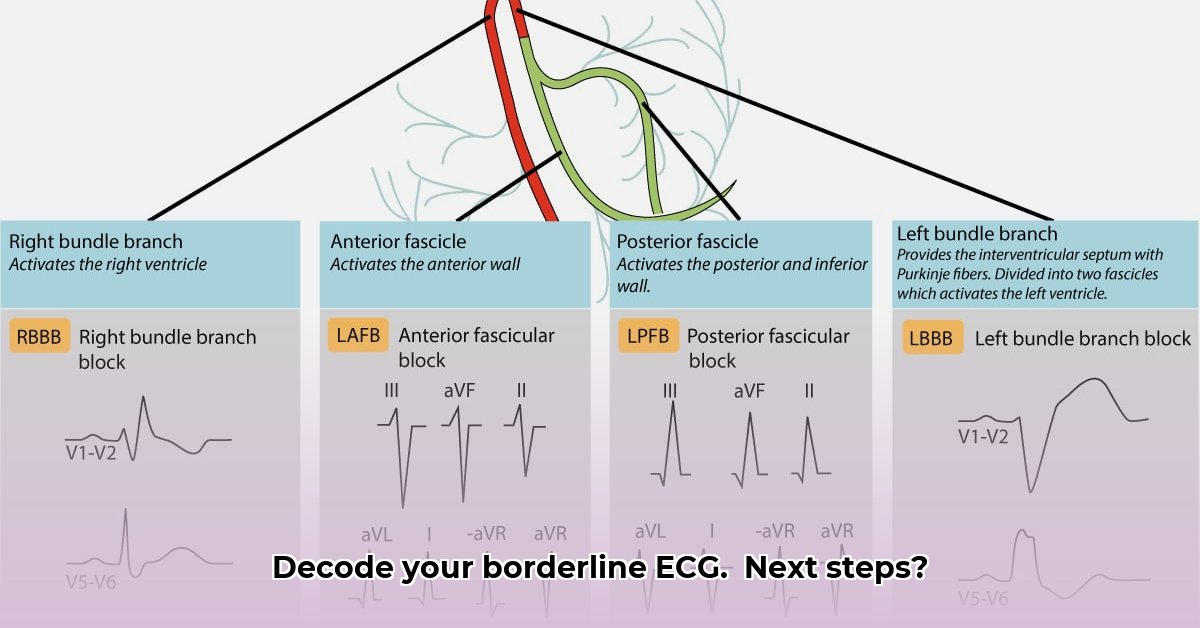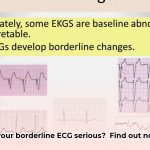Got a borderline ECG result and feeling a little lost? Don’t worry, you’re not alone. Many people find these results confusing, and it’s completely normal to feel anxious. This guide is here to help you understand what a borderline ECG means in simple terms, without all the medical jargon. We’ll cover what might cause a borderline reading, what steps you should take next, and how you can take care of your heart health. For more information on next steps, see this helpful guide on [what to do next](https://www.mearnes.com/what-to-do-after-a-borderline-ecg). Think of it as your personal roadmap to understanding your ECG and taking control of your heart health. Let’s break it down together and get you the answers you need.
Borderline ECG Explained Simply
Understanding a borderline electrocardiogram (ECG), which measures the heart’s electrical activity, can be straightforward. It’s unsettling to get test results that aren’t perfectly clear. Remember, a borderline ECG doesn’t automatically mean you have a serious heart problem. Think of it like this: your doctor got a slightly blurry picture of your heart’s electrical activity. They can see the main outlines, but some details need a closer look. This simply means more information is needed to get a complete picture. We’ll break it down so you understand what’s happening.
What Does a Borderline ECG Mean?
Exploring irregular heart rhythm signals
A borderline ECG means your heart’s electrical signals showed minor irregularities during the test. It’s not a diagnosis in itself – it’s more like a flag saying, “Let’s take a closer look.” The ECG measures your heart’s rhythm and electrical activity. A borderline result might show slight variations in heart rate, tiny blips in the electrical signals, or minor deviations from the normal pattern. While these quirks usually aren’t a major cause for concern, they’re enough to trigger further investigations to make sure everything is okay. Your doctor needs a clearer picture to feel confident in giving you a diagnosis.
Why Might My ECG Be Borderline?
Deciphering potential causes of inconclusive results
Several things can contribute to a borderline ECG. It’s not always easy to pinpoint the exact reason, but here are some possibilities:
-
Stress and Anxiety: We all experience stress, and chronic or intense stress can really affect your heart rhythm. The surge in stress hormones like cortisol and adrenaline can disrupt the heart’s natural electrical pathways, leading to temporary irregularities. Similarly, anxiety before or during the ECG can influence the results.
-
Electrolyte Imbalances: Electrolytes like potassium, sodium, calcium, and magnesium are crucial for your heart’s electrical conductivity. An imbalance – for example, low potassium (hypokalemia) or low magnesium (hypomagnesemia) – can disrupt the smooth flow of electrical signals, resulting in a borderline ECG. Think of electrolytes as the conductors in your heart’s electrical system.
-
Medications: Certain medications can influence your heart rate and rhythm. These include over-the-counter drugs, prescription medications, and even some herbal supplements. Beta-blockers, decongestants, thyroid medications, and some antidepressants are known to affect ECG readings.
-
Underlying Health Conditions: Sometimes, a borderline ECG reflects an underlying medical condition that might be affecting your heart’s function. This could include high blood pressure, an overactive thyroid (hyperthyroidism), sleep apnea, or even early stages of coronary artery disease.
-
Lifestyle Factors Diet, exercise, and substance use can also play a role in borderline ECG results. High caffeine intake, alcohol consumption, smoking, dehydration, and lack of regular physical activity can all influence heart rhythm.
-
Technical Factors: Believe it or not, the way the ECG is performed can also affect the results. Poor electrode placement, movement during the test, or even interference from other electronic devices can lead to a borderline reading.
-
Other Factors: Sometimes, there’s no readily identifiable cause for a borderline ECG. There can be many nuances and variations in heart patterns that are not completely understood yet. Ongoing research continues to uncover more about the complexities of heart rhythm.
What Should I Do Next?
Actionable steps following a borderline ECG result
Don’t panic! The most crucial step is to discuss your results with your doctor. They’ll consider your ECG alongside your overall health, any symptoms you might have (like palpitations or dizziness), and your medical history. A collaborative approach is key.
Step 1: Schedule a Follow-Up Appointment: This is the very first thing you should do. Aim to schedule an appointment with your doctor as soon as possible, preferably within a week or two of receiving your results. This allows for timely discussion and planning of any necessary follow-up tests or lifestyle adjustments. When scheduling, inform the receptionist about your borderline ECG result; this helps them allocate sufficient time for your consultation.
Step 2: Prepare for Your Appointment: Before your appointment, take some time to gather relevant information. This includes:
- A list of all medications, supplements, and over-the-counter drugs you’re currently taking, including dosages.
- A detailed account of any symptoms you’ve been experiencing, such as chest pain, palpitations, shortness of breath, dizziness, or fainting spells. Note when these symptoms occur and what triggers them.
- A record of your lifestyle habits, including your diet, exercise routine, caffeine and alcohol consumption, smoking status, and stress levels.
Step 3: During the Appointment: Your doctor will review your medical history, conduct a physical exam, and discuss your symptoms and lifestyle habits. Be prepared to answer questions about your family history of heart disease, as this can provide valuable insights into your risk factors. Don’t hesitate to ask your doctor any questions you might have about your ECG results, potential causes, and next steps.
Step 4: Consider Further Testing: Your doctor might suggest additional tests to get a clearer picture. These could include:
- Repeat ECG: In some cases, a repeat ECG may be ordered to confirm the initial findings and rule out any temporary factors that might have influenced the results.
- Holter Monitor: This is like a 24/7 ECG. You wear a small device that continuously monitors your heart’s rhythm for 24-48 hours, or even longer. This helps identify patterns that a single ECG might miss.
- Event Recorder: An event recorder is similar to a Holter monitor, but it only records your heart’s activity when you experience symptoms. You activate the device when you feel palpitations, dizziness, or other concerning sensations.
- Echocardiogram: This is an ultrasound of your heart that provides images of your heart’s structure and function. It’s a non-invasive way to evaluate how well your heart is working.
- Stress Test: A stress test monitors your heart’s activity while you exercise on a treadmill or stationary bike. It helps assess how your heart responds to physical stress and can reveal any underlying problems with blood flow.
- Blood Tests: Blood tests can help identify electrolyte imbalances, thyroid problems, or other underlying medical conditions that might be contributing to your borderline ECG.
Step 5: Follow Your Doctor’s Recommendations: It’s crucial to follow your doctor’s recommendations for further testing and treatment. Attend all scheduled appointments, take any prescribed medications as directed, and adhere to any lifestyle changes that your doctor recommends.
Step 6: Expect Open Communication: Your doctor should clearly explain the results of any further tests and outline the next steps. Don’t hesitate to ask questions; clear communication is essential. If you’re not comfortable with your doctor’s recommendations, seek a second opinion from another healthcare professional.
Lifestyle Changes to Support Your Heart Health
Adopting heart-healthy habits for better cardiac function
Regardless of the reason for your borderline ECG, adopting a heart-healthy lifestyle can have many benefits. These positive changes reduce your risk of heart problems and improve your overall health.
| Lifestyle Change | Benefits | Why It Matters |
|---|---|---|
| Regular Exercise (at least 150 minutes of moderate-intensity or 75 minutes of vigorous-intensity aerobic activity per week) | Strengthens your heart muscle, improves blood flow, helps manage weight, lowers blood pressure and cholesterol, and helps manage stress. | A stronger heart is a healthier heart. Exercise also helps regulate your heart rhythm and reduces your risk of heart disease. |
| Balanced Diet (lots of fruits, vegetables, whole grains, and lean protein) | Provides essential nutrients, helps maintain a healthy weight, lowers blood pressure and cholesterol, and reduces inflammation. | Proper nutrition fuels your body and supports heart health. A diet rich in fruits, vegetables, and whole grains provides essential vitamins, minerals, and fiber. |
| Stress Management Techniques (yoga, meditation, deep breathing, spending time in nature) | Reduces stress hormones that can negatively affect your heart rhythm, lowers blood pressure, improves sleep, and promotes overall well-being. | Stress takes a toll on your body. Learning to manage stress is immensely beneficial for your heart health and overall well-being. |
| Limiting or Avoiding Tobacco and Excessive Alcohol | Protects your cardiovascular system from damage, prevents long-term harm, lowers blood pressure, and reduces the risk of heart disease and stroke. | These substances are harsh on your body, including your heart. Smoking damages blood vessels and increases your risk of |
- How Much Do Wellness Programs Cost Businesses To Offer? - December 16, 2025
- Wellness Fair Ideas for Work to Boost Employee Wellbeing - December 15, 2025
- Affordable Employee Wellness Fair Ideas for Any Budget - December 14, 2025
















